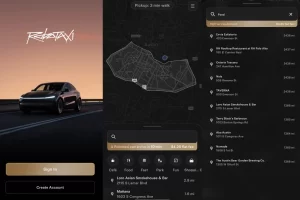- 🚖 The Tesla Cybercab, a self-driving robotaxi, is being showcased at the Petersen Automotive Museum in Los Angeles this holiday season.
- 🌍 Tesla is actively promoting its self-driving technology, with Cybercab prototypes spotted in various Tesla stores and Giga New York.
- 🤖 The Cybercab was part of the “We, Robot” event held at Warner Bros. Studios in October, where it offered autonomous rides to attendees.
- 🚪 The Cybercab features dihedral doors, seating for two passengers, and a cargo hatchback, all operable without pedals or a steering wheel.
- 🚀 The Cybercab employs the same computing and sensing technology as Tesla’s current vehicle fleet, aligning with Tesla’s goal to “democratize transportation.”
The holiday season in Los Angeles has become even more exciting with the showcase of Tesla’s self-driving innovation at the Petersen Automotive Museum. The Tesla Cybercab is not just a marvel of modern engineering but a testament to the future of automated transportation. In this blog post, we will delve deep into what makes the Cybercab a groundbreaking development in the world of autonomous vehicles and how Tesla is steering towards “democratizing transportation.”
The Cybercab: A Glimpse into the Future
The Tesla Cybercab, an avant-garde self-driving robotaxi, is currently one of the main attractions at the renowned Petersen Automobile Museum in Los Angeles. This placement isn’t merely for show; it reflects a definitive push by Tesla to immerse the public in the possibilities offered by autonomous vehicle technology.
Key Features
1. Design and Functionality
- Dihedral Doors: The vehicle is outfitted with a sophisticated set of dihedral doors that open automatically, adding a touch of futuristic elegance while enhancing ease of access.
- Spacious Seating: Inside, the Cybercab accommodates two passengers comfortably, ensuring a personalized experience.
- Cargo Hatchback: For practical uses, the Cybercab includes a hatchback for cargo, making it versatile for various transportation needs.
2. State-of-the-Art Technology
- Pedal and Steering Wheel-Free Operation: One of the standout features of the Cybercab is its lack of traditional driving controls, operating entirely on advanced autonomous technology.
- Computing and Sensing Suite: It utilizes the same reliable computer and sensing suite as other vehicles in Tesla’s fleet, ensuring it benefits from robust, well-tested systems.
Democratizing Transportation: Tesla’s Vision
Expanding Accessibility
Tesla’s mission to democratize transportation is central to the introduction of the Cybercab. By eliminating the need for human drivers, Tesla envisions a future where mobility is vastly more accessible, thereby transforming public and private transport landscapes.
Economic and Environmental Impact
- Reduction in Transportation Costs: Autonomous technology can significantly lower the cost of travel, as there are no driver wages and potentially less need for personal vehicle ownership.
- Sustainable Energy Usage: As part of Tesla’s electric vehicle lineup, the Cybercab promotes clean energy usage, contributing to a reduction in urban pollution and reliance on fossil fuels.
Spotlight Event: “We, Robot”
The Cybercab gained momentum during the highly publicized “We, Robot” event at Warner Bros. Studios in October. This unique event allowed attendees to experience the Cybercab firsthand, offering rides that showcased its fully autonomous capabilities.
Conclusion
Tesla’s Cybercab is more than just an autonomous vehicle; it is a beacon to a future where transportation is accessible, affordable, and environmentally friendly. With such innovations, Tesla is not only changing how we perceive travel today but also setting the standard for tomorrow’s mobility. The Petersen Automotive Museum’s display serves as a fitting platform for people to engage with and understand the breadth of what the future of transportation holds.





